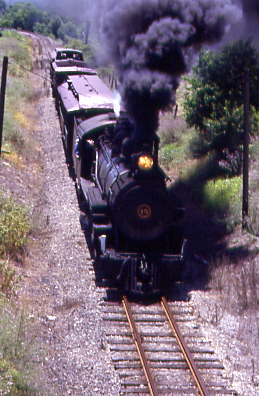
Chris Parker and I arose on this sunny summer morning and after packing, checked out of the Huntington Motor Inn then stopped at Sheetz for some breakfast before driving US 22 east to Mt. Union where we saw a wooden railroad crossbuck. We turned left on the street before it and drove about six blocks then turned right and at the tracks, I asked Chris to stop.
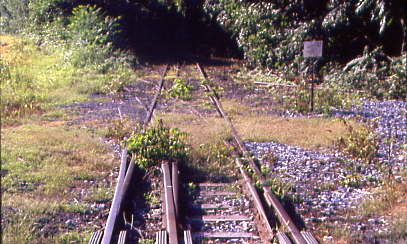
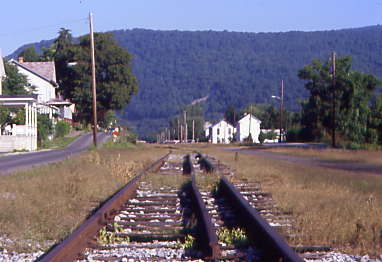
The reason we stopped was because we found the former dual gauge track shared by the East Broad Top and Pennsylvania Railroads. Chris needed a few items so we stopped at Safeway then went exploring.

The Pennsylvania Railroad freight station, which has been through a number of different configurations. The two-story part of this building was added to the freight house that was built here sometime before 1894. In the early 1900's, the freight station was extended and then sometime between 1911-1919, this two story section was added on. Then, sometime after it went out of service, the original part of the freight house was torn down, leaving only the two story addition. The one-story extension is a replica of the original freight house and was added on when the station was restored.
We decided to make our way to Orbisonia by taking Pennsylvania Highway 7474 south but that was wrong since there was no railroad grade running up the valley. We back-tracked into Mount Union and found US 522 and noticed that the East Broad Top Railroad tracks still exist in many locations. After Shirleysburg, the tracks of the came into view and it all looked familiar to me from seeing videos of this railroad over the years. We drove through Orbisonia and soon found the Orbisonia station and parked.
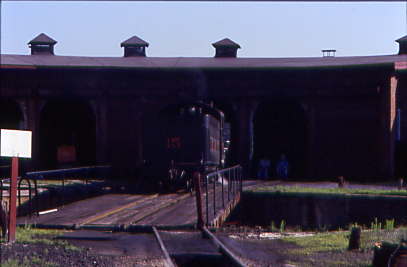
East Broad Top 2-8-2 15 built by Baldwin in 1914 coming onto the turntable for the day's activities.
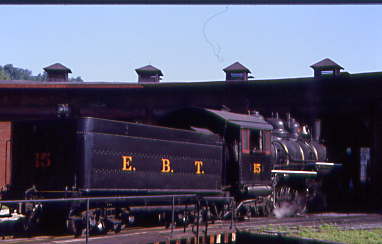
We walked over to the roundhouse and I met Stanley Hall, General Manager of the East Broad Top Railroad and introduced myself. He said we could look around the property all we wanted. This is a very well-preserved railroad and the remaining buildings are fantastic to see.
East Broad Top Railroad HistoryOperating from 1871 to 1956, it is one of the nation's oldest and best-preserved narrow-gauge railroads and was designated a National Historic Landmark in 1964. The railroad is now preserved for use as a tourist attraction.
The EBT is unusual in that it is a complete, original railroad rather than a collection of pieces from various locations, as most tourist railroads are. All six of the narrow gauge steam locomotives that operated on the railroad in its last years as a coal hauler are still on site, and some were used for the excursion trains. Other original equipment includes a standard gauge switcher steam locomotive (non-operational), operating track-gang cars, the M-3 motorcar (built from scratch by the EBT with an engine and transmission from an automobile) and the M-1, a motorcar based on scaled-down J. G. Brill and Company plans built by the EBT in 1927. The majority of rolling stock that operated on the railroad in its later coal-hauling years remains on the property in varying condition, including over a dozen flatcars, several boxcars and well over 150 hoppers. Tourist trains used original EBT passenger equipment, as well as converted EBT freight cars. The original railroad maintenance shops have a pair of Babcock & Wilcox boilers, a 19th-century stationary steam engine and an overhead line shaft system (steel shafts, wood and iron pulleys and leather and canvas belts) that powers antique machine tools, sheet-forming machines, foundry equipment, blacksmithing tools and woodworking machines. Most of the 33 miles of the railroad's original main 30 mile line is still in place, though only five miles are usable. In recent years, disused trackage from Rockhill Furnace southward and Robertsdale southward have been cleared and gauged for use with speeders and handcars.
Common Carrier Operations - 1872 to 1956The East Broad Top Railroad and Coal Company was chartered in 1856. Due to financial constraints and the American Civil War, the railroad was not built by its original charterers, but a new group of investors began to acquire right-of-way in 1867 and was able to construct the railroad as a narrow gauge line in 1872–1874. Service began from Mount Union to Orbisonia in August 1873, and to Robertsdale in November 1874. The line later was extended to Woodvale and Alvan with several short branches. At its height, it had over 60 miles of track and approximately 33 miles of main line.
The primary purpose of the railroad was to haul semi-bituminous coal from the mines on the east side of the remote Broad Top Mountain plateau. In its first few decades, the railroad hauled most of the coal to Rockhill to be coked and used in iron production in the furnaces of the Rockhill Iron and Coal Company, its sister company. It then hauled the pig iron from the furnace. Shortly after the turn of the 20th century, the railroad transitioned to haul most of the coal to Mount Union to be processed and transferred to the Pennsylvania Railroad. The railroad also carried substantial amounts of ganister rock, lumber and passengers with some agricultural goods, concrete, road tar and general freight.
As the iron industry in the region faded in the early 1900's, the railroad came to subsist on coal traffic for about 90 percent of its revenue. Large plants for the manufacture of silica brick were developed at Mount Union around the turn of the 20th century, and these became major customers for coal and also for ganister rock, which was quarried at multiple points along the railroad.
The EBT maintained an office in Philadelphia. An 1893 timetable lists their executive offices at 320 Walnut Street, then the main commercial area of the city. The city's business center migrated west and by 1939, the EBT's office was at 1421 Chestnut Street. EBT was generally profitable from the 1880's through the 1940's and was able to modernize its infrastructure far more than other narrow gauge railroads. The railroad's roundhouse, one of the oldest railroad roundhouses in the country still in operation, was built in 1882. A coal cleaning plant and a full maintenance shop complex were also built, bridges were upgraded from iron and wood to steel and concrete, wood rolling stock was replaced by steel, and modern high-powered steam locomotives were bought from Baldwin Locomotive Works of Philadelphia. In the post-World War II years, most railroads converted to diesel motive power but the EBT considered this switch unnecessary. Steam locomotives had proven longevity and, as EBT was a coal carrier, fuel was abundant and cheap.
In 1929 the EBT formed the East Broad Top Transit Company and operated regional bus service, acquiring the Mount Union Bus Line in 1931. In 1941 this operation was sold to the Huntingdon Bus Company.
In November 1953, the railroad's innovation earned them a cover story in an industry publication. But coal demand was already plummeting as homes and industries switched to cheap oil and gas. The last nail in the coffin came when the silica brick plants in Mount Union converted to oil and gas and not enough coal could be sold to support the mines and the railroad. The railroad closed as a coal hauler on April 14, 1956 and along with the coal-mining company, was sold for scrap to the Kovalchick Salvage Corporation.
Nick Kovalchick, president of Kovalchick Salvage, elected not to scrap the railroad right away, instead letting it sit in place. In 1960, the twin boroughs of Orbisonia and Rockhill Furnace - the latter being the operating hub for the railroad - celebrated their bicentennial and asked Kovalchick to put a train out for display. Doing them one better, he rehabilitated four miles of track and two locomotives and operated tourist train rides for several months that summer.
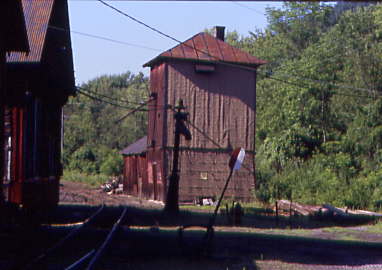
Water tower.
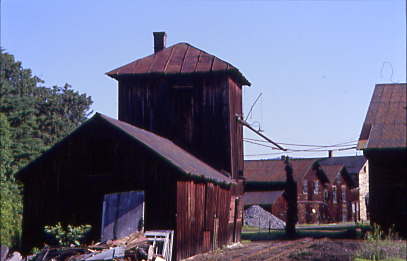
Water tower and sandhouse.
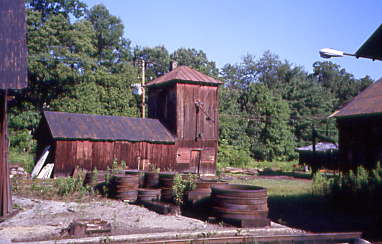
Side view of water tower and sandhouse.
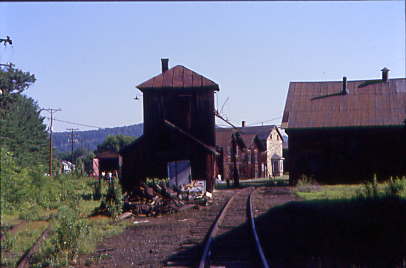
The water tower and machine shop to the right; the paint shop to the left.
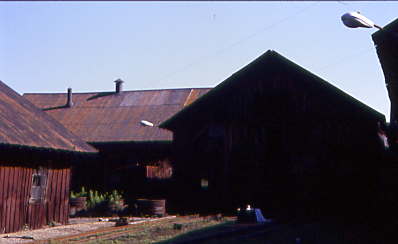
Carpentry shop and machine shop.
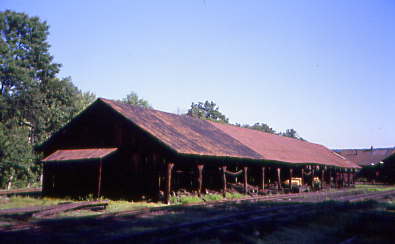
Lumber shed.
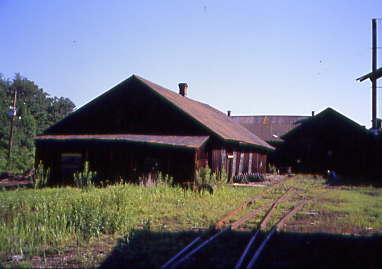
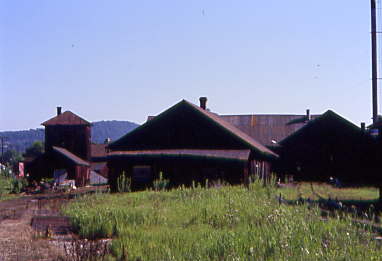
The carpentry shop.
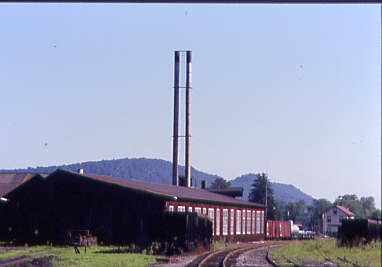

Car shop.

Coal tipple and shacks.
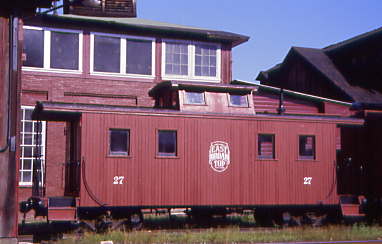
East Broad Top caboose 27 built by the railroad in 1920.
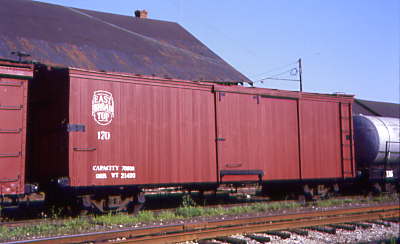
East Broad Top box car 170 built by the railroad in 1913.
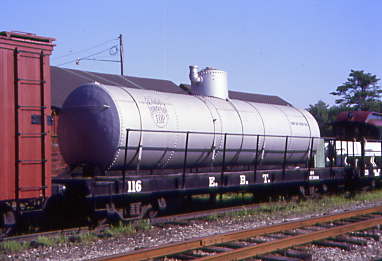
East Broad Top tank car 116, nee East Broad Top flat car 116 built by the railroad in 1923.
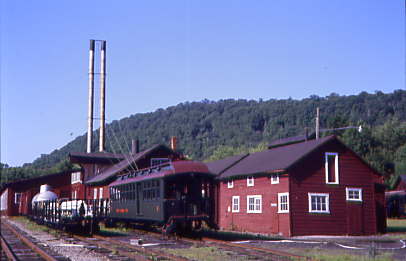
EBT passenger coach and electrical shop.
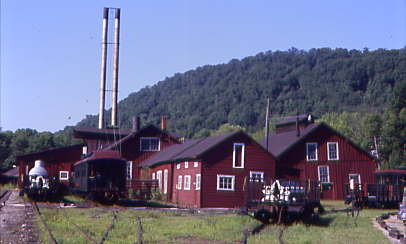
Electrical shop and blacksmith shop.

The roundhouse, built in 1882.
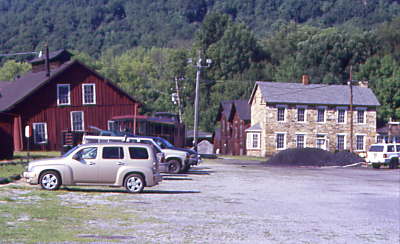
Superintendent's office and blacksmith shop.

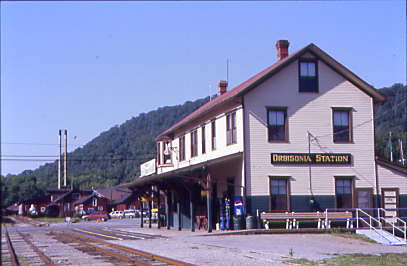
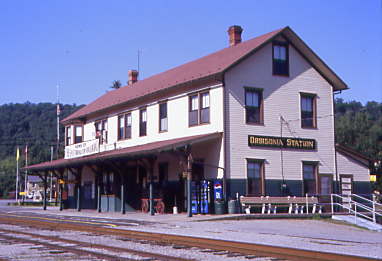
Across the road is East Broad Top Orbisonia station built in 1906, which houses the ticket office and gift shop.

The EBT tracks north of the station.
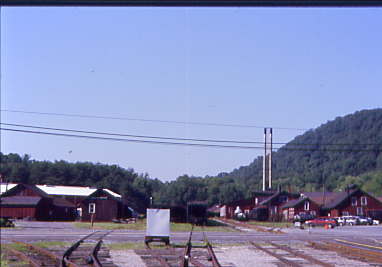
The view looking south back towards the yard. The Rockhill Trolley Museum brought out their car for the day's runs and Chris and I walked over there as they were expecting us. See the story above this in the Index.
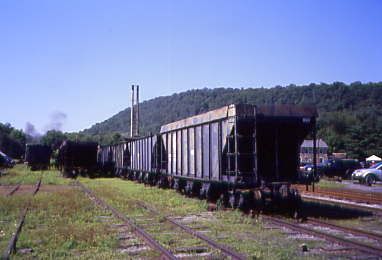
After our tour and ride at the Rockhill Trolley Museum, we walked back to the East Broad Top tracks and I spotted smoke.
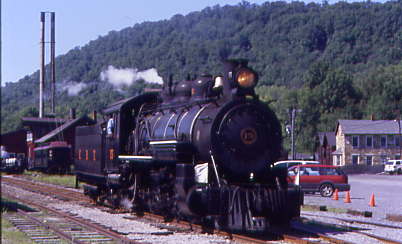
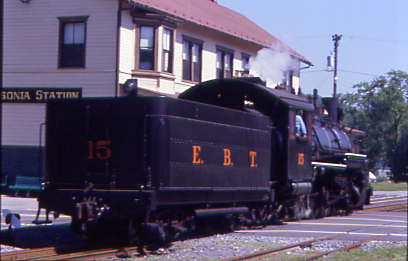
East Broad top 2-8-2 15 came down the mainline, pulled by us and waited to throw a switch before reversing to make up its train.
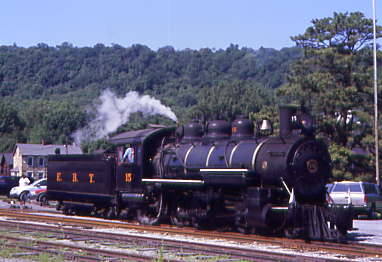
The steam engine reversing past me.

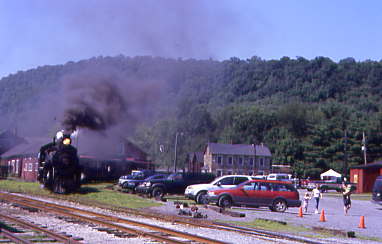
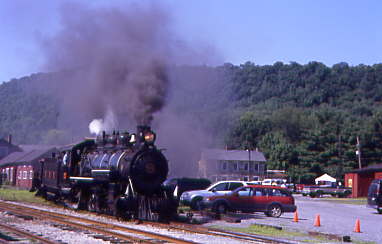
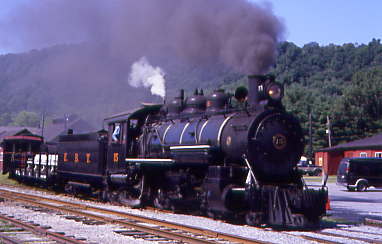
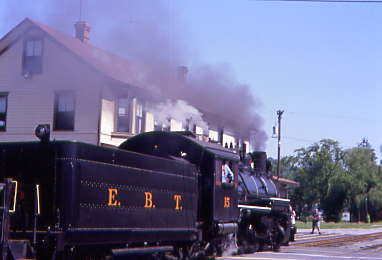
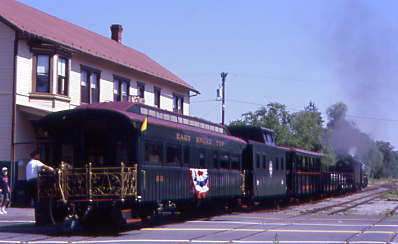
With the train made up, EBT 15 then came unto the station. I bought a ticket for Chris and used a free Internet coupon I had printed as my ticket, purchasing a pair of seats in the covered open car so we could avoid the cinders. Our train consisted of EBT 2-8-2 15, open car 117, open car 119, covered open car 175, caboose 28 and parlour car 20.
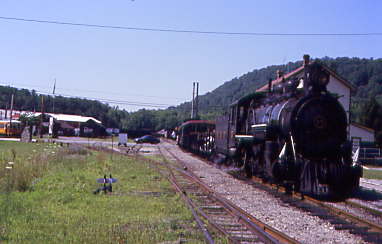

We chose a bench in 175 and after a few minutes, I detrained for a few more pictures, met our engineer, gave him my business card and told him we would be chasing the 1:00 PM departure, to which he replied that he would look for us. Upon our return, an elderly couple was late arriving and with the train about to depart, they had no place to sit. Chris and I gave up our seats for them and would both stand at the end of the car for the whole trip. After all these years, I was finally going to be riding the East Broad Top Railroad, a goal in my railroading life.
The 11:00 AM Departure Trip on the East Broad Top RailroadAt 11:00 AM, EBT 15 blew its whistle and we started rolling away from the Orbisonia station, proceeding north crossing Blacklog Creek.
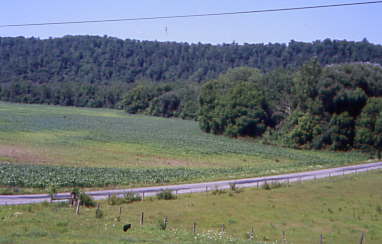
Once out of town, we started seeing the Pennsylvania countryside for which this railroad is known.
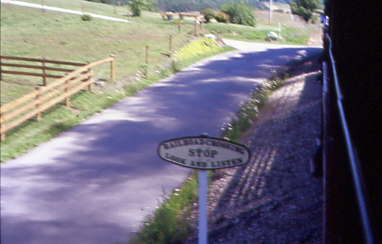
Passing the railroad crossing sign at the first crossing north of town.
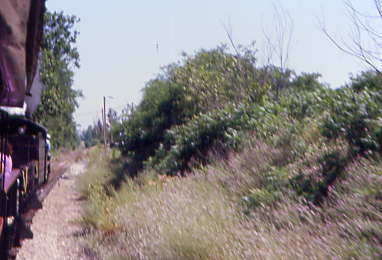
Rounding a slight curve.

Passengers enjoying our covered open car.
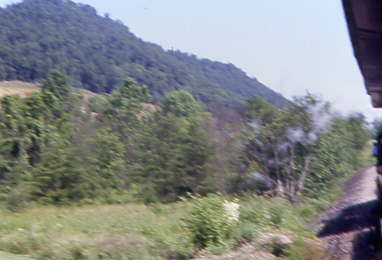
A nice little hill.
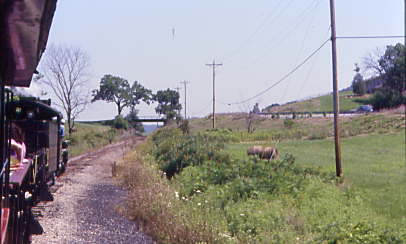
The train curved to the famous bridge that many photographers have used over the years.

Rolled hay in this field.
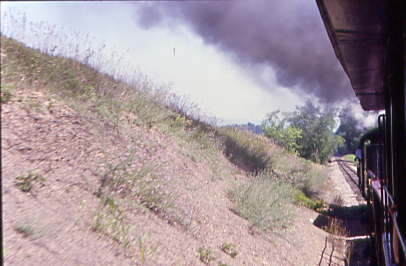
Trails of smoke as we rounded another slight curve.

Crossing a bridge over a farm road before approaching the wye running into the forest.

The Runk Road bridge to the west.
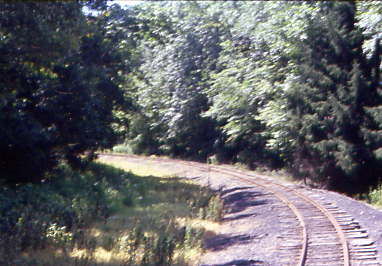
A few minutes later, we arrived at Colgate Grove wye. Once we passed this switch, we would reverse down this leg.
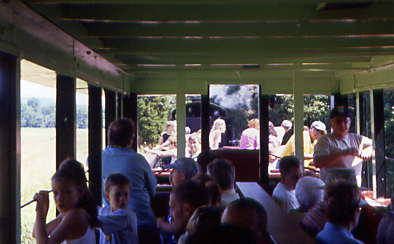
Passengers enjoying the covered open car.
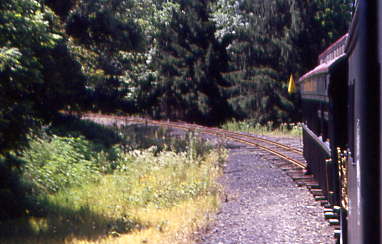
Here the parlour car led our train down the leg of the wye.
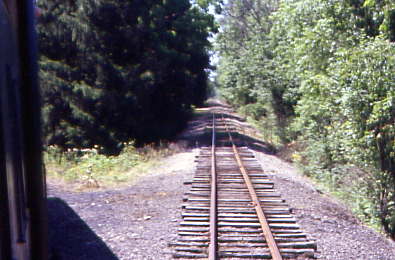
The track upon which we arrived.
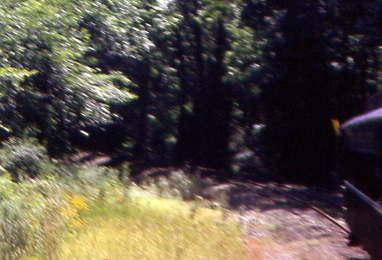
We continued to reverse.
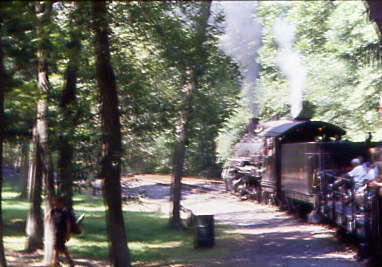
EBT 15 then took us ahead to the Colgate Grove picnic area where we had ten minutes on the ground.

Our train at rest.
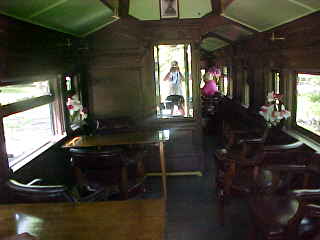
Interior of East Broad Top parlour car 20, nee Bradford, Bordell and Kinzua Railroad 20 built by Billmeyer and Smalls in 1882. This was the President of the EBT's private car.
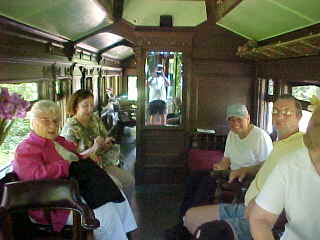
I got caught in the mirror taking this picture of the other end of the parlour car with some happy passengers aboard.

Parlour car 20 at the rear of our train.
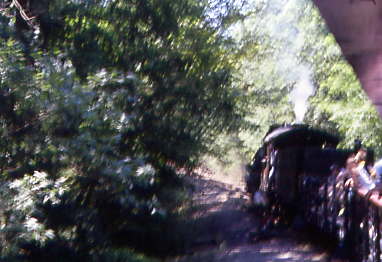
All the passengers reboarded and we started back towards Orbisonia.
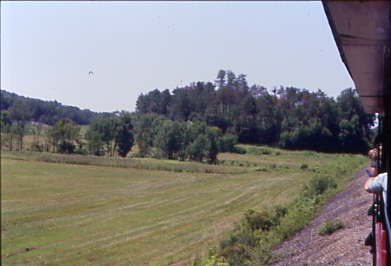
We passed many fields.
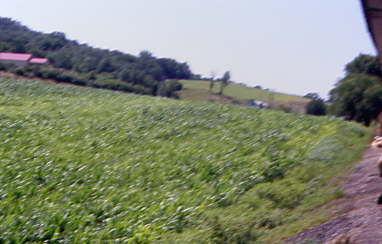
The corn field that will come into play later on this day.

A slight curve by a tree.
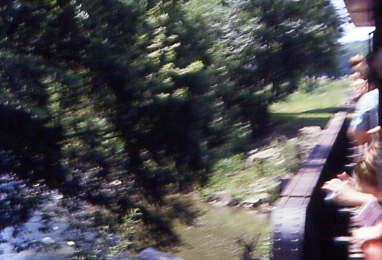
Crossing the bridge over Blacklog Creek.
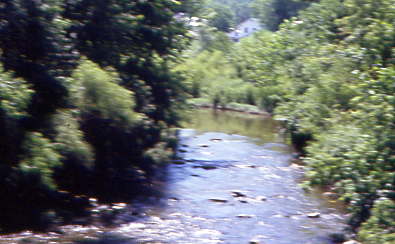
Blacklog Creek.
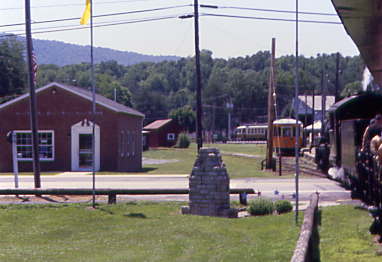
Back at Orbisoniam we entered the Rockhill Trolley Museum and started around the wye on dual gauge track with the trolleys waiting before they started another trip. Steam engines under trolley wire does not happen everyday in many places, does it?
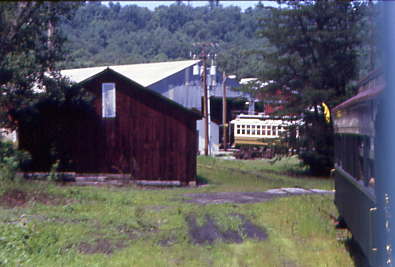
Once we had pulled passed the switch, we started reversing around the other leg of the wye.
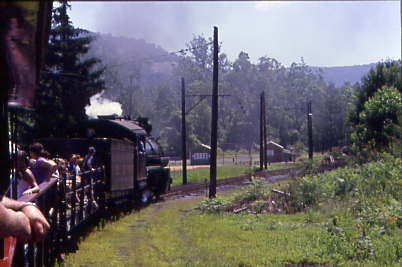
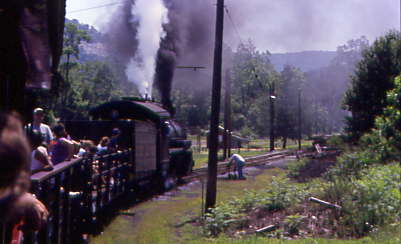
EBT is pushing around this leg of the wye.
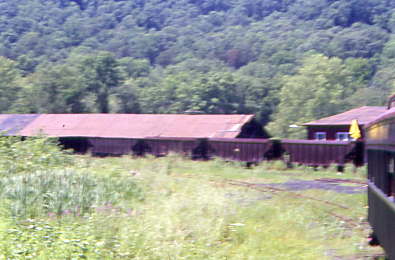
The parlour car nearing the mainline.
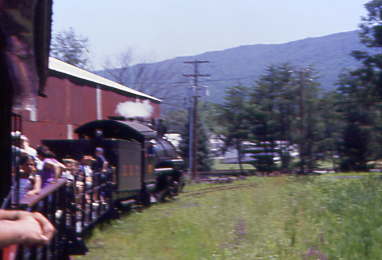
EBT 15 was still pushing.
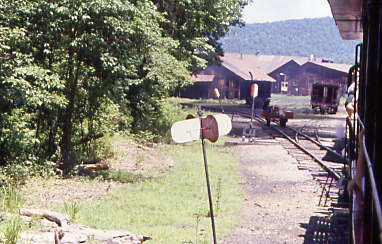
Our covered open car had now reached the mainline.
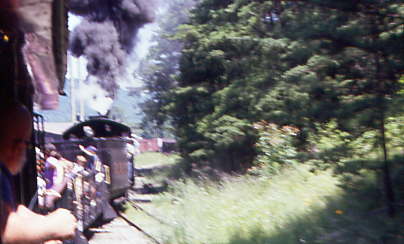
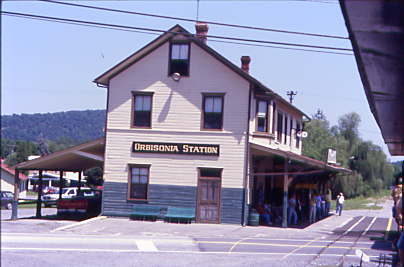
I thanked our crew members before visiting the gift shop for a T-shirt and went in search of something to eat on the two properties while Chris Parker shopped. We had no luck and Chris had to get cash since the East Broad Top does not accept credit cards. We went to a market that had a Subway then to a bank and returned to Orbisonia station where Chris bought his souvenirs, after which we departed for our first photo location for the 1:00 PM departure.
The East Broad Top 1:00 PM ChaseChris and I enjoyed our Subway sandwiches on US 522 opposite the first grade crossing north of Orbisonia.
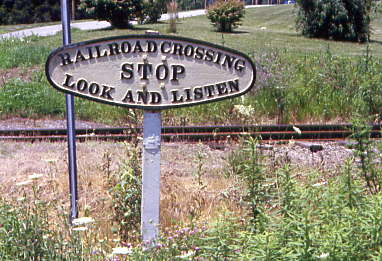
A unique sign that protects the grade crossing.

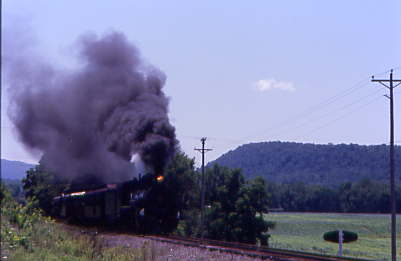

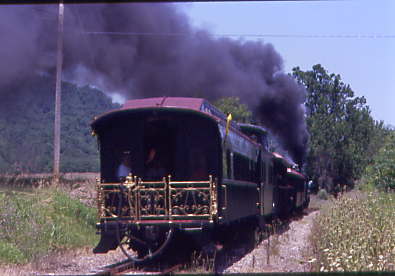
At 1:20 PM we photographed the train as it approached What smoke! We hopped into the car and drove to the bridge over the tracks.
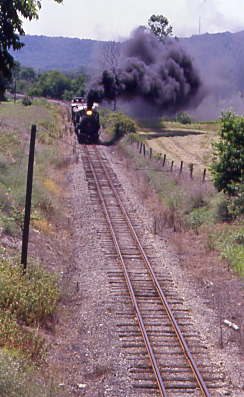


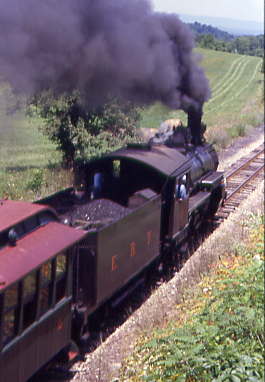
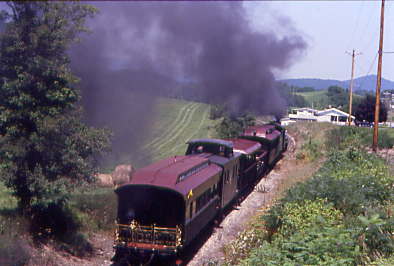
From the bridge we had a fantastic vantage point, then it was back into car to the next spot. As we passed that corn field, I asked Chris to stop and we walked across the highway.
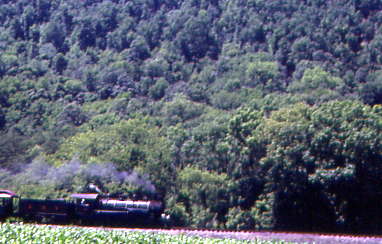
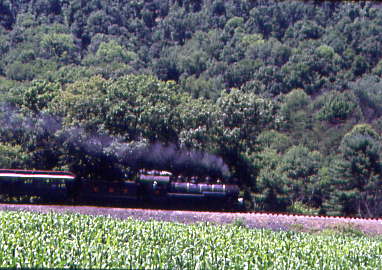
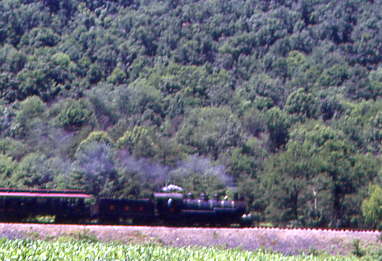
After these side pictures, we drove to the farm road for the last passing of the EBT train today.
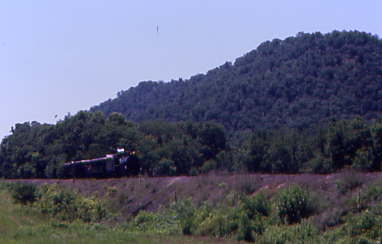
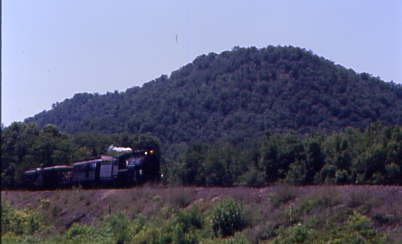
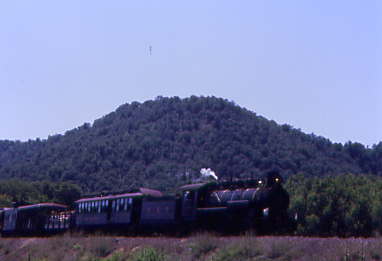
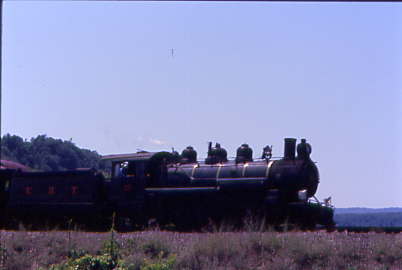
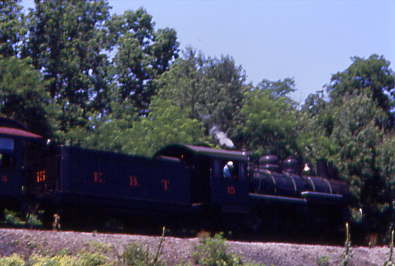
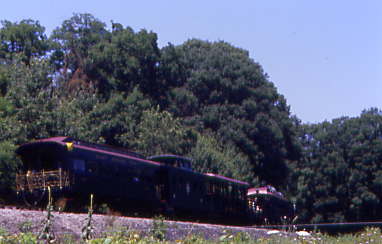
Our final picture, from the Runk Road bridge. Following what I would call excellent chase and Chris Parker's first chase of a steam train, it was now time to say goodbye to the East Broad Top Railroad. What a great time we had here! We would drive back the Horseshoe Curve and then to the Tunnel Inn for the night, but that is another story.
| RETURN TO THE MAIN PAGE |